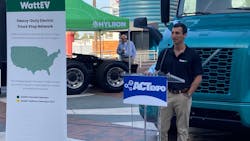WattEV to build charging station at Port of Long Beach
LONG BEACH, California—WattEV is building a charging plaza for heavy-duty electric trucks inside the Port of Long Beach.
The charging station is one of several that are under construction now by WattEV and marks the beginning of the electric-truck corridor from Southern California to Sacramento, the company announced here at the Advanced Clean Transportation (ACT) Expo. The corridor is expected to be completed within the next couple of years.
“This project is an exciting opportunity in WattEV’s near-term plans to build an electric-truck charging ‘highway’ from the Port of Long Beach to Sacramento by the end of 2023,” Salim Youssefzadeh, CEO of WattEV, said during a press conference at ACT Expo.
The charging facility would serve WattEV’s fleet of electric trucks as well as other carriers committed to electrifying trucking operations to and from the combined Ports of Long Beach and Los Angeles, which receive about 40% of the nation’s imported goods.
Combined, the ports have 20,000 trucks in their registries using combustion engines, more than 25% of which are older than 10 years. Both ports have been setting clean-air goals for nearly two decades.
“WattEV’s electric charging facility at the Port of Long Beach would be a major step toward encouraging transporters to transition to zero-emission trucking,” Youssefzadeh said.“This charging station represents the southern anchor of our ‘Electric Highway,’ serving heavy transport corridors in Southern California as well as northbound freight through the San Joaquin Valley. Sacramento is the northern anchor for our infrastructure development. We’re planning two more e-truck charging plazas between there and Long Beach,” Youssefzadeh said.
WattEV is working with Southern California Edison (SCE) to power its charging stations throughout SCE’s service area, including those under construction in Gardena, San Bernardino, and the planned Port of Long Beach charging plaza.
WattEV’s e-truck charging plaza at the port—designed for everyday use by drayage operators and longer-haul fleets—initially will feature 26 charging bays using Combined Charging System (CCS) connectors to provide power at up to 360 kilowatts. The CCS system is the current charging standard for heavy-duty e-trucks, while faster charging systems are under development.
With the availability of trucks with megawatt charging capability, eight more e-truck bays are planned at the Port of Long Beach charging plaza, featuring the faster, higher-power Megawatt Charging System (MCS), rated for charging at up to 1.2 megawatts.
Electric trucks as a service
In addition to its e-truck charging network, WattEV also will operate its own fleet of branded electric trucks for its trucks-as-a-service (TaaS) program. WattEV is expecting initial deliveries to begin by the end of this year for 50 Volvo VNR Electric trucks on order, and several hundred more from various manufacturers thereafter.
Under WattEV’s TaaS system, large and small fleet operators that join WattEV’s service platform can electrify their freight operations on a pay-as-you-go basis.
The TaaS program will be up and running by the end of this year, Youssefzadeh said during an ACT Expo press conference. He added that the company is in the beta phase, testing internally with WattEV employees and drivers.
Carriers and owner-operators interested in the WattEV TaaS option don’t have to worry about buying the electric truck up front. That, Youssefzadeh noted, removes some of the limited range capabilities and electrification unknowns that exist for owner-operators.
“We came up with the solution of bridging that gap and making [fleet electrification] more affordable and accessible to all,” Youssefzadeh explained, added that the company will offer a full-service agreement inclusive of the truck.
WattEV has set a goal of putting 12,000 electric heavy-duty trucks on the road with a supporting infrastructure by 2030. To that end, WattEV is actively building additional electric truck charging stations in Bakersfield, Gardena, San Bernardino, and expects to break ground in Sacramento at a solar-powered facility on U.S. Interstate 5 across from the Sacramento International Airport air freight hub.
The charging network and WattEV’s heavy-duty e-fleet will facilitate the zero-emission transport of goods to and from air and ocean ports and large warehouses in the Inland Empire, the Sacramento region, and the agricultural sectors of the vast San Joaquin Valley.
“We’re on schedule to build out electric truck stops from the ports to Southern California warehouses and up I-5 and Highway 99 to Sacramento, and east along the I-10 to Barstow, Blythe and neighboring states, and beyond,” said Youssefzadeh.
As WattEV moves toward revenue generation in 2023, the company intends to scale up its operations for expansion over the next several years, Youssefzadeh added.
Beyond California, WattEV has sites under evaluation eastbound towards Arizona, Nevada, and Texas.
“None of this can be possible without the help of grants and alternative funding to really bring down the price, which is why we actually put it into trucking as a service concept to really bridge the gap of where the trucks are today and where they need to be more accessible to owner-operators and various carriers,” Youssefzadeh explained. “But we are going to be expanding outside of California fairly soon.”
About the Author

Cristina Commendatore
Cristina Commendatore is a past FleetOwner editor-in-chief. She wrote for the publication from 2015 to 2023.

